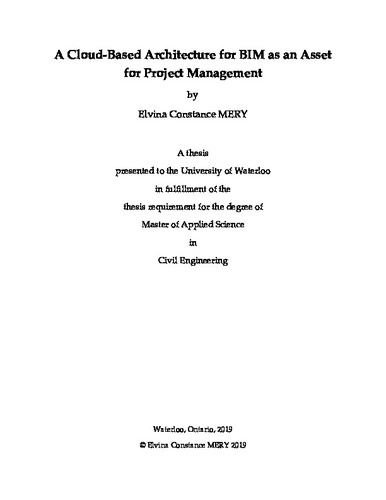| dc.contributor.author | MERY, ELVINA Constance | |
| dc.date.accessioned | 2019-08-12 12:52:47 (GMT) | |
| dc.date.available | 2019-08-12 12:52:47 (GMT) | |
| dc.date.issued | 2019-08-12 | |
| dc.date.submitted | 2019-08-02 | |
| dc.identifier.uri | http://hdl.handle.net/10012/14866 | |
| dc.description.abstract | After more than 30 years of research, better solutions continue to be sought for nuclear power plant decommissioning and radioactive waste management. As some approaches are interesting, improvements are still required in order for them to become generalized solutions.
This thesis is a part of a larger research project that focuses on developing robotic and automated technologies that could support the decommissioning of the nuclear power plant in Pickering, Ontario. The overarching research project is divided into four main tasks: (i) automatic scanning of parts of a nuclear power plant; (ii) creation of BIMs (Building Information Models) from these scans for integrated asset management, and decommissioning planning and analysis; (iii) non destructive evaluation of elements in the nuclear power plant; and (iv) packing optimization of the radioactive waste for its storage and management.
This thesis concerns the second part of the project: creating BIM from the scans (point clouds) generated automatically by a robotic mobile platform. Using Revit® and Recap®, the point clouds are opened in the software and the BIM is created manually from them. A comparison with automatic recognition is made and the limits of both methods are analyzed in order to present the state of the art of automation in this process and the future improvements that can be done.
Dividing this larger research project into four tasks is necessary but creates data management problems, representative of the decommissioning planning challenge. In fact all the data is collected separately with no common storage. Because of the size of this project, it appears possibly advantageous to create an interface where all the data can be shared and accessible by all allowed members. However, the confidentiality of some information must be respected. The security aspect of the developed cloud-based interface is introduced in this thesis and its different functions are presented.
The working environment programmed here can be utilized as an approach for BIM-based asset and project management. To prepare for future modifications and generalization to other domains or fields of construction, it has the advantage of being customizable. Indeed, all the functions here are coded in Javascript and are designed for this nuclear power plant decommissioning project. But other functionalities can be developed and existing ones can be suppressed to suit perfectly another project. | en |
| dc.language.iso | en | en |
| dc.publisher | University of Waterloo | en |
| dc.title | A Cloud-Based Architecture for BIM as an Asset for Project Management | en |
| dc.type | Master Thesis | en |
| dc.pending | false | |
| uws-etd.degree.department | Civil and Environmental Engineering | en |
| uws-etd.degree.discipline | Civil Engineering | en |
| uws-etd.degree.grantor | University of Waterloo | en |
| uws-etd.degree | Master of Applied Science | en |
| uws.contributor.advisor | Haas, Carl | |
| uws.contributor.affiliation1 | Faculty of Engineering | en |
| uws.published.city | Waterloo | en |
| uws.published.country | Canada | en |
| uws.published.province | Ontario | en |
| uws.typeOfResource | Text | en |
| uws.peerReviewStatus | Unreviewed | en |
| uws.scholarLevel | Graduate | en |

